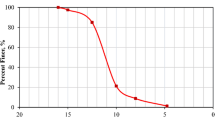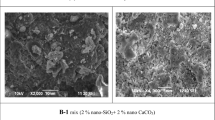Abstract
In this study, the effects of micro- and nano-CaCO3 addition on the early-age properties of ultra-high-performance concrete (UHPC) cured at simulated cold and normal field conditions were investigated. The micro-CaCO3 was added at rates of 0, 2.5, 5, 10 and 15 %, while the nano-CaCO3 was added at rates of 0, 2.5, and 5 %, both as partial volume replacement for cement. Results indicate that micro-CaCO3 acted mainly as an inert filler, creating a denser microstructure and increasing the effective w/c ratio. In addition, nano-CaCO3 accelerated the cement hydration process through nucleation, and also acted as an effective filling material. Mixtures combining both micro- and nano-CaCO3 resulted in similar or enhanced mechanical properties compared to that of the control, while achieving cement replacement levels up to 20 %. Thus, through the use of micro- and nano-CaCO3, more environmentally friendly UHPC can be produced by reducing its cement factor, while achieving enhanced engineering properties.

















Similar content being viewed by others
References
Meyer C (2009) The greening of the concrete industry. Cement Concr Compos 31(8):601–605
Sato T (2006) Applications of nanotechnology for the sustainable development of cement-based materials, PhD Thesis, University of Ottawa, 171 p
Myers R (2007) Calcium carbonate, 100 most important chemical compounds: a reference guide. Greenwood Press, Westport, pp 59–61
Péra J, Husson S, Guilhot B (1999) Influence of finely ground limestone on cement hydration. Cement Concr Compos 21(2):99–105
Granger S, Loukili A, Pijaudier-Cabot G, Chanvillard G (2005) Mechanical characterization of self-healing effect of cracks in Ultra High Performance Concrete (UHPC) In: Proceedings of 3rd international conference on construction materials, performance, innovations and structural implications, Vancouver, August 22–24
Soliman AM, Nehdi ML (2011) Effect of drying conditions on autogenous shrinkage in ultra-high performance concrete at early-age. Mater Struct 44(5):879–899
Bentz D (2005) Replacement of ‘coarse’ cement particles by inert fillers in low w/c ratio concretes: II. Experimental validation. Cem Concr Res 35(1):185–188
Thomas M, Hooton D, Cail K, Smith B, De Wal J, Kazanis K (2010) Field trials of concrete produced with Portland limestone cement. Concr Int 32(1):35–41
Balaguru PN (2005) Nanotechnology and concrete: Background, opportunities and challenges. In: Proceedings of international conference on applications of nanotechnology in concrete design, Thomas Telford Services Ltd., Scotland, pp 113–122
Nazari A, Riahi S (2010) Micro-structural, thermal, physical and mechanical behavior of the self-compacting concrete containing SiO2 nano-particles. Mater Sci Eng A 527(29–30):7663–7672
Nazari A, Riahi S (2010) The effect of TiO2 nano-particles on water permeability and thermal and mechanical properties of high strength self-compacting concrete. Mater Sci Eng A 528(2):756–763
Nazari A, Riahi S (2011) Improvement of compressive strength of cementitious composites in different curing media by Al2O3 nano-particles. Mater Sci Eng A 528(3):1183–1191
Jo B, Kim C, Tae G, Park J (2007) Characteristics of cement mortar with nano-SiO2 particles. Constr Build Mater 21(6):1351–1355
Sato T, and Beaudoin JJ (2006) The effect of nano-sized CaCO3 addition on hydration of OPC containing high volumes of ground granulated blast-furnace slag. In: Proceedings of the 2nd International RILEM symposium on advances in concrete through science and engineering, Québec City, pp 355–366
Paolini M, Khurana R (1998) Admixtures for recycling of waste concrete. Cement Concr Compos 20(2–3):221–229
Sato K, Li J, Kamiya H, Ishigaki T (2008) Ultrasonic dispersion of TiO2 nanoparticles in aqueous Suspension. J Am Ceram Soc 91(8):2481–2487
Bentz DP, Sato T, De la Varga I, and Weiss J (2011) Fine limestone additions to regulate setting in high volume fly ash mixtures. Date retrieved August 3. http://concrete.nist.gov/~bentz/Finelimestoneadditions061011.pdf>
Ma J, Orgass M, Dehn F, Schmidt D, and Tue NV (2004) Comparative investigations on ultra-high performance concrete with and without coarse aggregates. In: Proceedings of international symposium on ultra high performance concrete, Germany, pp 205–212
Holschemacher K, Dehn F, Klotz S, and Weiße D (2005) Experimental investigation on ultra high-strength concrete under concentrated loading. In: Proceedings of 7th international symposium on utilization of high-strength/high performance concrete, vol 2, Washington DC, pp 1145–1158
ASTM C 1437-7 (2007) Standard specification for flow of hydraulic cement mortar. American Society for Testing and Materials, Philadelphia, 2 p
ASTM C191-08 (2008) Standard test method for time of setting of hydraulic cement by Vicat needle. American Society for Testing and Materials, Philadelphia, 8 p
Loukili A, Khelidj A, Richard P (1999) Hydration kinetics, change of relative humidity, and autogenous shrinkage of ultra-high-strength concrete. Cem Concr Res 29(4):577–584
Mounanga P, Khelidj A, Loukili A, Baroghel-Bouny V (2004) Predicting Ca(OH)2 content and chemical shrinkage of hydrating cement pastes using analytical approach. Cem Concr Res 34(2):255–265
ASTM C 157/157M-08 (2008) Standard test method for length change of hardened hydraulic-cement mortar and concrete. American Society for Testing and Materials, Philadelphia, 7 p
Pane I, Hansen W (2005) Investigation of blended cement hydration by isothermal calorimetry and thermal analysis. Cem Concr Res 35(6):1155–1164
Jensen OM, Hansen PF (1995) A dilatometer for measuring autogenous deformation in hardening Portland cement paste. Mater Struct 28(181):406–409
Elkhadiri I, Diouri A, Boukhari A, Aride J, Puertas F (2002) Mechanical behavior of various mortars made by combined fly ash and limestone in Moroccan Portland cement. Cem Concr Res 32(10):1597–1603
Esping O (2008) Effect of limestone filler BET(H2O)-area on the fresh and hardened properties of self-compacting concrete. Cem Concr Res 38(7):938–944
Liu X, Chen L, Liu A, Wang X (2012) Effect of nano-CaCO3 on properties of cement paste. Energy Procedia 16(Part B):991–996
Liu XY, Wang XR, Liu AH, Chen L (2012) Study on the mechanical properties of cement modified by nanoparticles. Appl Mech Mater 157–158:161–164
Nehdi M, Soliman A (2011) Early-age properties of concrete: overview of fundamental concepts and state-of-the-art research. ICE Constr Mater 164(2):57–77
Schindler AK (2004) Effect of temperature on hydration of cementitious materials. ACI Mater J 101(1):72–81
Mark JM, Chan GW (2009) Growth of cement hydration products on single-walled carbon nanotubes. J Am Ceram Soc 92(6):1303–1310
Lea FM, (1998) Lea’s chemistry of cement and concrete 4th (edn). Hewlett PC (Ed), Wiley, New York, 1053 p
Bonavetti V, Donza H, Menéndez G, Cabrera O, Irassar EF (2003) Limestone filler cement in low w/c concrete: a rational use of energy. Cem Concr Res 33(6):865–871
Bentz DP, Peltz MA, Winpigler J (2009) Early-age properties of cement-based materials: II. Influence of water-to-cement ratio. ASCE J Mater Civil Eng 21(9):512–517
Opoczky L (1992) Progress of the particle size distribution during the intergrinding of a clinker-limestone mixture. Zement-Kalk-Gips 45(12):648–651
Shihada S, Arafa M (2010) Effects of silica fume, ultrafine and mixing sequences on properties of ultra-high performance concrete. Asian J Mater Sci 2(3):137–146
Tafraoui A, Escadeillas G, Lebaili S, Vidal T (2009) Metakolin in the formulation of UHPC. Constr Build Mater 23(2):669–674
Soroka I, Setter N (1977) The effect of fillers on strength of cement mortars. Cem Concr Res 7(4):449–456
Xu QL, Meng T, Huang MZ (2011) Effects of nano-CaCO3 on the compressive strength and microstructure of high strength concrete in different curing temperature. Appl Mech Mater 121–126:126–131
Amen DKH (2011) Degree of hydration and strength development of low water-to-cement ratios in silica fume cement system. Int J Civil Environ Eng 11(5):10–16
Wang Y, Wang W, Guan X (2011) Physical filling effects of limestone powders with different particle size. Adv Mater Res 163–167:1419–1424
Coussy O, Dangla P, Lassabatère T, Baroghel-Bouny V (2004) The equivalent pore pressure and the swelling and shrinkage of cement-based materials. Mater Struct 37(1):15–20
Holt E (2005) Contribution of mixture design to chemical and autogenous shrinkage of concrete at early ages. Cem Concr Res 35(3):464–472
Bucher B (2009) Shrinkage and shrinkage cracking behavior of cement systems containing ground limestone, fly ash, and lightweight synthetic particles. M.Sc Thesis, Purdue University, 190 p
Soliman A (2011) Early-age shrinkage of ultra high-performance concrete: mitigation and compensating mechanisms, PhD Thesis, University of Western Ontario, 382 p
Author information
Authors and Affiliations
Corresponding author
Rights and permissions
About this article
Cite this article
Camiletti, J., Soliman, A.M. & Nehdi, M.L. Effects of nano- and micro-limestone addition on early-age properties of ultra-high-performance concrete. Mater Struct 46, 881–898 (2013). https://doi.org/10.1617/s11527-012-9940-0
Received:
Accepted:
Published:
Issue Date:
DOI: https://doi.org/10.1617/s11527-012-9940-0




